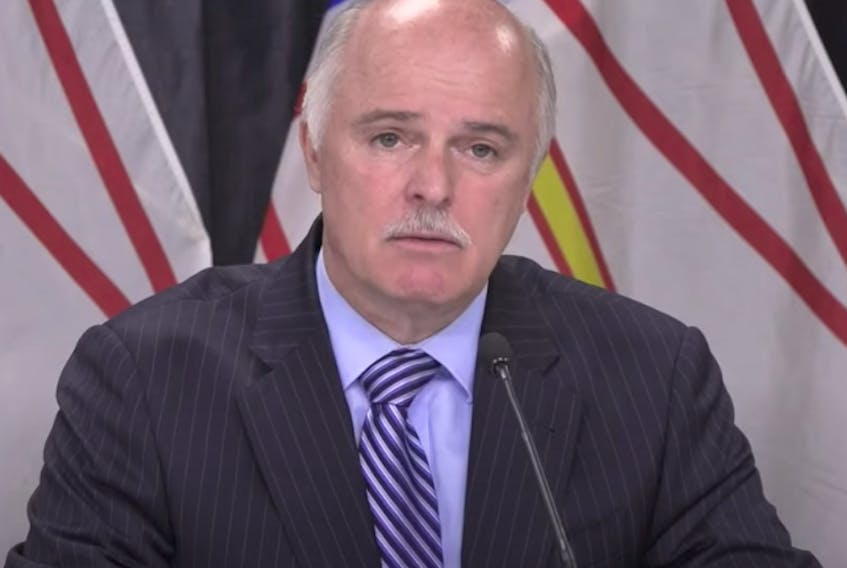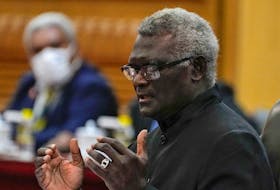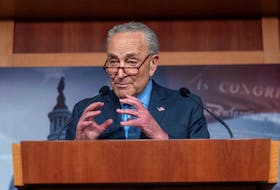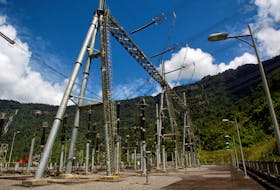The days of $2-billion deficits have returned to Newfoundland and Labrador, as the economic effect of the COVID-19 pandemic rears its head.
Finance Minister Tom Osborne says all aspects of the economy of the province have felt the effects of the virus and the shutdown of the province in March and April.
“Obviously, this has been a difficult year. In 2020, we faced two crises: a public-health crisis as well as a fiscal crisis. I don’t think it should come as a surprise that most economic indicators are down,” said Osborne.
Revenue projections decreased by $631 million, with $560 million of that related to the drop in oil prices and resulting royalties.
Nalcor Energy also saw a $225 million loss in revenue as a result of the shutdown of the White Rose and Hibernia South Extension, due to the drop in the price of oil. Those results impact the 2019-20 fiscal year, dropping that year’s “surplus” from $1.9 billion to $1.04 billion. The surplus is the result of counting the Atlantic Accord dollars in one year. The revised deficit for 2019-20 discounting the Atlantic Accord numbers is closer to $1.3 billion.
Osborne says the federal government is going to need to step up to help the province through the fiscal challenges.
“Whether its fiscal stabilization or equalization, I can’t repeat often enough that we’re not looking for special treatment: we’re looking for fair treatment,” said Osborne.
“If other provinces with less challenges than we’ve had are entitled to equalization, the federal government has to look at that program.
Expenses rose by $720 million, with $200 million related to the creation of a pandemic contingency fund, $127 million related to pension and debt expenses, and other expenses of $132 million.
Among the expenditure increases are $261 million related to health care. The department says about $90 million is directly related to COVID-19.
While specifics were not available Friday, a “large portion” of that COVID-19 cost is directly attributed to purchasing personal protective equipment for the healthcare system.
The net debt of the province is another concern stemming from the update.
Instead of $14.6 billion as originally projected, the province’s net debt will soar to $16.7 billion. In 2019-20, the province spent $1.3 billion on debt servicing. That figure will increase by approximately $80 million to $85 million in the revised forecast, according to Osborne.
Muskrat Falls accounts for just over $100 million in annual debt expenses for the province.
Progressive Conservative Leader Ches Crosbie says the debt needs to be addressed.
“It is an enormous problem. That’s why we need to get the federal government focused on how it is we’ve been disadvantaged within Confederation and how to fix the problems in three areas right now,” said Crosbie.
“One is the offshore (which) — under Trudeau, Trudeau Liberalism — the federal government seems determined to ignore,” Crosbie said. “The other is contributing investment money by turning debt guarantees into equity for Muskrat Falls. The other is fixing the system of federal transfer monies so that we can provide to our population the equality of services enjoyed in the rest of the country that is promised in the constitution.”
Another difficult figure for the province is continued outmigration.
Friday’s projections suggest 3,700 people will search for greener pastures in 2020-21.
Osborne says there are major ripple effects to the loss of population that will compound the issues facing the province.
“It is challenging, there’s no question, it’s challenging on a number of fronts. As people leave the province, money that we get from Ottawa is per-capita based. As people leave, we get less money from Ottawa, as people leave there’s less tax revenue paid into the province,” said Osborne.
“It’s generally the younger people that leave, so it compounds the ageing population impacts. It is concerning.”
New Democratic Party Leader Alison Coffin says the ripple effect of outmigration is an even bigger problem than the fiscal picture presented on Friday.
“The people who are leaving are not the people who are seniors, who are retired, who own their home, who are comfortable where they are. These are more often than not young people who have less of an attachment to the workplace, who may or may not own a home here, who have a lot more mobility in terms of job prospects and their future,” said Coffin.
“Not only are they leaving, but any babies they may have are all leaving as well. That’s eroding our job market, our potential hires, our education system is being eroded and our taxpayers are leaving.”
Coffin says a wealth tax is one quick way to help turn the economy in the right direction.
“One of the things they do need to consider is perhaps a wealth tax and incentives to keep more dollars circulating inside our province, instead of money leaving our province,” said Coffin.
“A wealth tax can manifest itself in a variety of ways, but if we have a whole lot of wealth that taxes are not being paid on, it is not being used for reinvestment and that money is sitting there stagnating, not being reinvested and not recirculating in our economy. We need to address that.”
The Atlantic Chamber of Commerce issued a statement on Friday expressing its concern with the ever-increasing debt burden of the province.
“There can be no doubt that Newfoundland and Labrador is faced with challenging times, only compounded by extraordinary global events currently taking place. These exceptional circumstances require the courage of bold leadership to lead us on a path of change,” reads the statement.
“With declining revenues and high expenditures, the government of Newfoundland and Labrador must have all options on the table to address the debt moving forward.”
While Friday’s figures offer an idea of where the province is today, the future of the COVID-19 pandemic and potential for a second wave of the virus returning and shuttering the economy again is keeping finance officials up at night.
“It’s something that’s hard to quantify,” said Osborne. “We don’t know. We’re told by health professionals to expect a second wave. We don’t know to what magnitude that will be
Osborne says a full budget will be delivered in September.”
Key economic indicators for 2020-21
Deficit: projected at $2.1 billion, up from April projection of $796 million
Nominal GDP: 29,319 million, down $6.4 million from budget 2019-20
Retail sales: $8.4 billion, down from $9.2 billion
Housing starts: 883, down from 1,060
Inflation rate: 1.0 per cent, down from 2.0 per cent
Capital investment: 8.7 billion, down from 9.2 billion
Population: 519,900 down from 523,000
Employment: 213,800, down from 225,200
Unemployment rate: 14 per cent, up from 13.5 per cent
Estimated price of oil in 2020-21: USD$34 per barrel, down from USD$68 per barrel
Exchange rate: 0.719, down from 0.772
Net Debt: $16.7 billion, up from $14.6 billion
@DavidMaherNL








